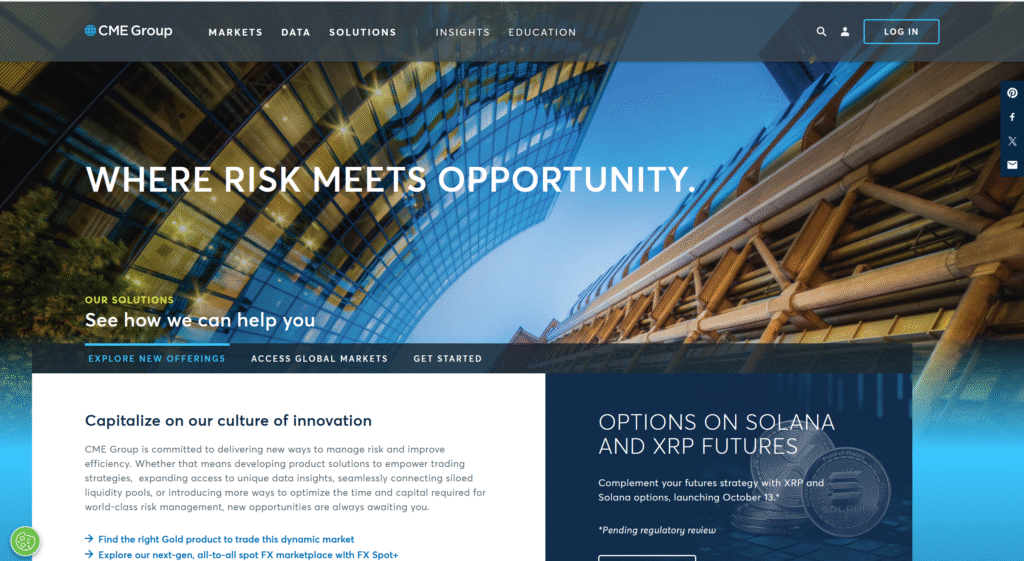1. What Is CME Group A Global Derivatives Powerhouse
CME Group is the preeminent global marketplace for derivatives trading, combining multiple major exchanges under one roof. It operates the exchanges CME, CBOT, NYMEX, and COMEX, each of which is a Designated Contract Market (DCM) regulated under U.S. laws.
Originally, the Chicago Mercantile Exchange (CME) was founded in 1848 for trading agricultural futures (as the Butter and Egg Board). Over time it expanded into financial futures, commodities, and more. It merged with the Chicago Board of Trade (CBOT) in 2007, and later acquired NYMEX/COMEX, forming the modern CME Group.
Today, CME Group offers futures and options contracts across major asset classes including interest rates, equity indices, foreign exchange, energy, agricultural products, and metals.

2. Regulation, Oversight & Self-Regulatory Duties
Because CME Group’s exchanges operate under U.S. regulation, they are subject to rigorous oversight. The exchanges are self-regulatory organizations (SROs) with market regulation arms that monitor trading, enforce rules, and ensure market integrity.
The Market Regulation Department conducts surveillance over trade behavior, monitors positions, reviews accounts, and enforces disciplinary actions when rules are broken.
Clearing, risk monitoring, and capital surveillance are handled via the Financial and Regulatory Surveillance unit, which ensures that clearing members maintain required capital, abide by segregation rules, and meet financial compliance obligations.
The exchanges each publish rulebooks that define how contracts operate, what behavior is allowed, how delivery works, and what restrictions (such as position limits) apply.
Overall, CME Group’s combination of external regulation (e.g. by the CFTC) and internal market regulation helps maintain trust in the platform.
3. Strengths & Competitive Position
- Scale & Liquidity: CME Group is among the largest derivatives exchanges globally, routinely handling billions of contracts worth trillions of dollars annually.
- Diverse Product Suite: It offers benchmark futures and options in interest rates, equities, FX, commodities, metals, and more.
- Innovation & Technology: CME pioneered electronic trading (via Globex), mini contracts (E-mini S&P 500), and continues investing in tech infrastructure to support global markets.
- Global Reach with Local Standards: Though based in the U.S., its contracts are used by institutions and traders globally, supported by data services, clearing, and cross-border infrastructure.
- Strong Financial & Risk Controls: Through its surveillance units and capital monitoring, CME ensures that default risk is minimized.
These attributes make CME Group more trusted than many smaller or unregulated platforms.
4. Risks & What Traders Need to Understand
Even a strong exchange like CME has risks and considerations:
- Complexity of Futures & Leverage: Derivatives carry leverage and margin. If markets move against you, losses can be substantial. Use risk management.
- Regulatory Compliance: Because CME is regulated, traders must comply with rules, reporting, and documentation.
- Access Requirements: Not everyone can trade directly — many retail traders use brokers or intermediaries.
- Clearing Member Requirements: Only qualified entities can directly clear, and they face capital and operational burdens.
- Market & Liquidity Risk: In volatile conditions, spreads, slippage, and volatility can increase.
- Contract Specifications & Expirations: Each futures/option contract has its own rules (delivery, rollover, expiry). Misunderstanding them causes errors.
Even though CME is highly reputable, it’s not immune to shocks or systemic stress, so users must understand terms of each contract and ensure margin and liquidity.
5. Recent Notable Actions & Developments
- In 2024, CME Group banned Russian-origin aluminium from its platform after U.S. and UK sanctions, ensuring compliance with international trade restrictions.
- CME Group is selling OSTTRA, its post-trade solutions joint venture with S&P Global, to private equity firm KKR for $3.1 billion. This move shows CME’s strategic rebalancing and focus on core functions.
- In a strong revenue period, CME posted a 13% increase in Q2 revenue, driven by geopolitical volatility and increased trading volumes across interest rates and commodities.
These moves reflect that CME remains active, evolving, and responsive to global trends.
6. How to Use CME Safely & Wisely
- Use regulated brokers to access CME markets — don’t fall for unverified platforms claiming “CME access.”
- Understand contract specs — margins, expiration, slippage, position limits.
- Start small — test with smaller trades until you understand mechanics.
- Watch margin calls — maintain buffer so you don’t get liquidated.
- Stay compliant — meet KYC, reporting, and regulatory requirements of your jurisdiction.
- Monitor news & regulation — geopolitical events and policy changes can affect futures markets heavily.
- Use CME’s educational & outreach resources — CME Group offers regulatory outreach programs to help participants comply.
Conclusion
CME Group is among the pillars of the global financial market infrastructure. Built from deep historical roots — from the Chicago Butter and Egg Board in 1848 to today’s merged complex of CME, CBOT, NYMEX, and COMEX — the company has evolved through consolidation, innovation, and scale.
This evolution has brought benefits: liquidity, reliability, regulatory oversight, and innovation in electronic trading. CME is not just a trading venue — it’s a risk management platform, connecting institutions, firms, producers, speculators, and governments. Its product lineup spans interest rates, commodities, equities, FX, and more.
The backbone of its credibility is the layered regulatory environment. It doesn’t operate in the shadows. Its exchanges are registered DCMs that must comply with U.S. laws and oversight by the CFTC, and they maintain internal market regulation enforcement teams to police conduct.
But that doesn’t mean trading there is risk-free. Leverage amplifies gains—and losses. Market volatility, margin calls, liquidity constraints, contract rollovers, and compliance burdens are all real challenges. Traders who lack knowledge may find themselves exposed.
Moreover, despite its strength, CME must adapt to global changes. The recent sanctioning of Russian-origin aluminum and the sale of its post-trade services arm (OSTTRA) show how regulatory pressure and strategic realignment drive change.
If you plan to interact with CME markets, do so through reputable channels. Use well-regulated brokers, read contract details, maintain risk buffers, and educate yourself on rulebooks and compliance. Always verify your broker’s legitimacy and your contract’s terms.
In a world where many platforms claim grand access or guaranteed returns, CME stands in contrast: foundational, regulated, complex, and trusted by institutions worldwide. It’s not a get-rich-quick tool. It’s infrastructure. Use it with care.





